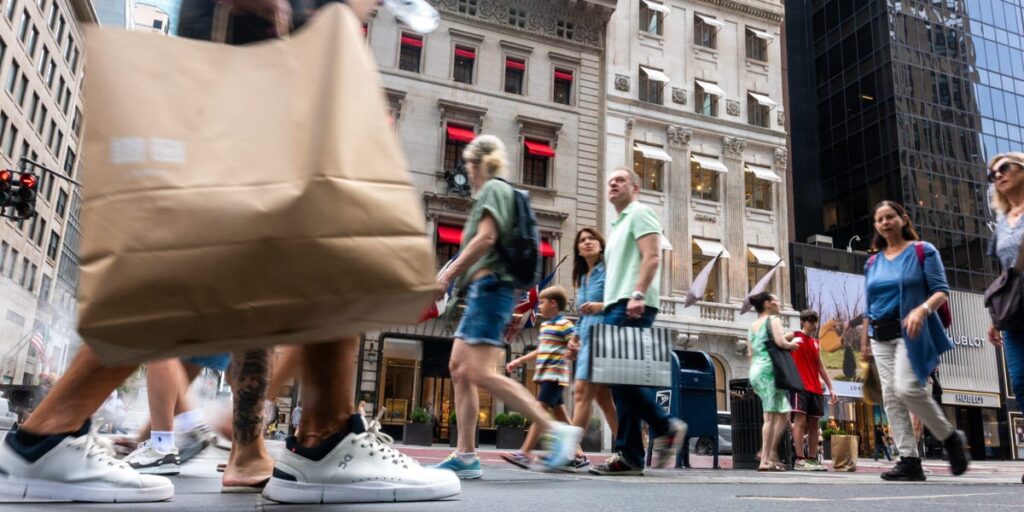If you’ve been waiting for the shoe to drop on the US consumer economy, keep waiting.
Strong results from some retail brands during the first half of this year are defying the economic warning bells that have been ringing for several quarters now.
Recent earnings calls have revealed a pattern that points to a continued split in Americans’ spending, and some CEOs are approaching the gap with caution.
2 types of spending
Looking at brands across the consumer economy, a tale of two shoppers emerges.
While consumers with annual earnings of at least $100,000 increased their spending in the first six months of 2025, those making less than $50,000 a year did almost the exact opposite, pulling back on spending each month, Morning Consult’s lead economist, Kayla Bruun, wrote last week.
“The story is inconsistent across income groups,” Bruun wrote.
Amazon CEO Andy Jassy said last week that the e-commerce juggernaut saw the biggest-ever Prime Day event and that tariffs haven’t caused much of a dent in the retail business.
“In the first half of the year, in the first half, we just haven’t seen diminished demand,” he said.
Please help BI improve our Business, Tech, and Innovation coverage by sharing a bit about your role — it will help us tailor content that matters most to people like you.
What is your job title?
(1 of 2)
What products or services can you approve for purchase in your role?
(2 of 2)
this data to improve your site experience and for targeted advertising.
By continuing you agree that you accept the
Terms of Service
and
Privacy Policy
.
Thanks for sharing insights about your role.
And Costco said said Wednesday that fiscal year comparable sales in the US are up 6.2% from the prior year, with visits up 4.3% in the US.
Those results might be hiding a more complicated picture, and the state of the US consumer will become clearer in the coming weeks when companies including Walmart and Target report their financials.
For now, though, companies are highlighting this growing divide between the wealthy and the less affluent.
While McDonald’s reported same-store sales growth of 3.8% on Wednesday, CEO Chris Kempczinski said the industry continues to see a decline in visits from low-income customers.
It’s a big focus for McDonald’s because low-income customers are more frequent buyers than those in higher income brackets, he said.
“This bifurcated consumer base is why we remain cautious about the overall near-term health of the US consumer. In this environment, we will continue to remain agile with respect to our value offerings to ensure the US strengthens its leadership in value and affordability,” Kempczinski said.
Kempczinski said that reintroducing menu items at the $2.99 price point was essential in improving customer perception of the burger chain’s value, especially as lower-income household budgets tighten.
Executives at Yum Brands and Chipotle have echoed the same sentiment in recent earnings calls. Both have launched value-driven promotions and limited-time menu offerings to drive foot traffic as quick-service restaurants see fewer customers coming through their doors.
Hotels are seeing a similar trend, Booking Holdings’ chief financial officer, Ewout Steenbergen, said on an earnings call last week.
“We see generally, top end of the US consumer market will be a little stronger, spending more in the 5-star hotel category, spending more on international travel,” he said.
“We see at the lower end, more careful behavior,” the CFO added. “Pressure on the domestic travel, on the lower-star rated hotels, so there is definitely a little bit more of the negative behavior that we see in terms of impact to the US consumer.”
Consumers are spending, but the devil is in the details
Another company that’s seeing a consumer split is Uber.
Uber’s ride-hailing business grew in the late spring, notching a 16% increase in revenue during the company’s latest quarter. Two groups of riders appear to be driving that growth. The company cited lifts from both its higher-priced rides, such as its Comfort and Black offerings, and from some options that generally carry cheaper fares, such as its wait-and-save option.
“Different parts of our demographic are sensitive to price, and then there are other parts of our demographic who want a premium product,” CEO Dara Khosrowshahi said. “So what you’re seeing from us is actually a barbell strategy.”
People also continue to spend on Uber’s services, especially for food delivery. The company’s delivery revenue rose 20%, beating analysts’ expectations in its second-quarter earnings report on Wednesday.
“At this point, we’re not seeing weakness in the consumer,” Khosrowshahi told CNBC on Wednesday.
Foot traffic data from Placer.ai and Colliers indicates that while retail visits were up compared to the same period a year earlier, customers favored more affordable brands and experiences — like Chili’s, Crunch Fitness, Ollie’s Bargain Outlet, and HomeGoods — over bigger-ticket discretionary purchases, like home improvement and electronics.
The analysis also found that brands with middle- and upper-income consumers, like Nordstrom, Staples, LA Fitness, and Barnes & Noble, saw the most significant gains in the first half of the year.
“This suggests that while value matters, brands don’t need the lowest prices to win customers,” Colliers’ national research manager for retail services, Nicole Larson, wrote about the chains that target more affluent shoppers. “Brands that effectively communicate their value proposition can thrive, no matter the final price point.”
Read the full article here


